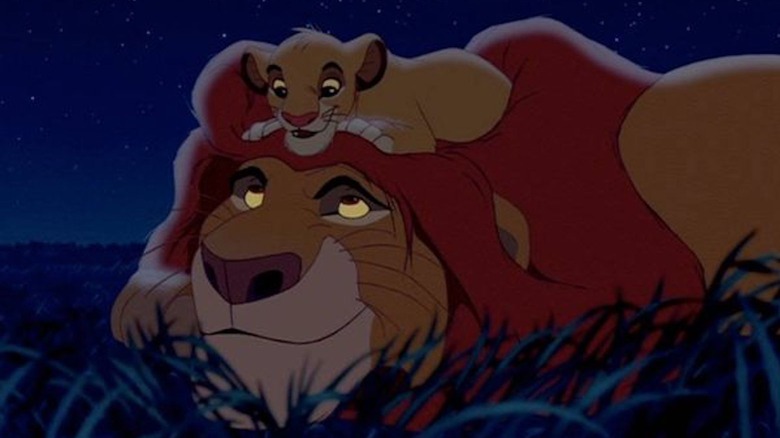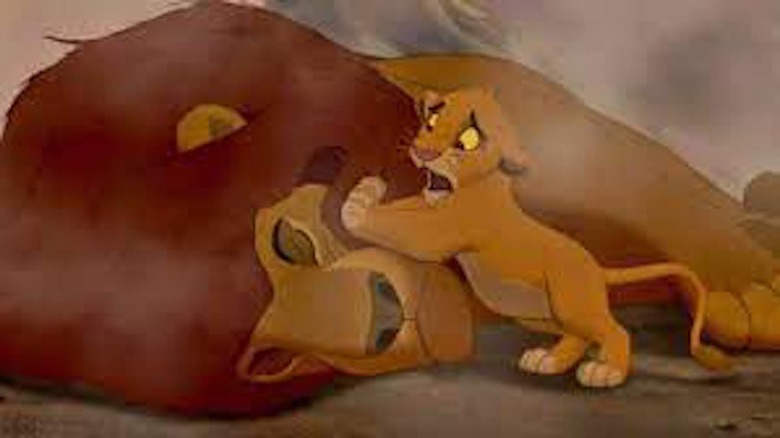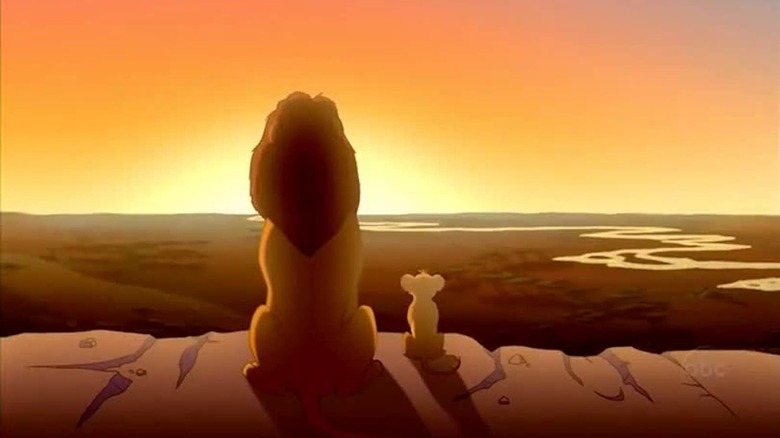How Mufasa's Death In The Lion King Broke The Rules Of Disney
Disney animated features have evolved over the past few decades, showcasing more diverse representation and original storylines. However, in the '90s, Disney maintained a fairly strict and formulaic storyline structure. Several of their animated hits during that decade were based on fairy tales and the protagonist usually had a broken nuclear family. "Beauty and the Beast" and "Aladdin" are two primary examples of this motif. But then there's the 1994 blockbuster "The Lion King," which was inspired by William Shakespeare's "Hamlet" and pushed the envelope with its shift in family dynamics in one of the most emotionally damaging animation scenes in history — the death of Simba's father, Mufasa.
In an interview with Collider, co-director Rob Minkoff spoke to the experimental structure of "The Lion King" and how an emotional risk ultimately paid off. Typically, an impactful death in a storyline occurs at the beginning of the film in the first reel. This method quickly addresses character building and sets the tone for the protagonist's subsequent journey. However, Mufasa dies nearly halfway through the film. This scene devastated audiences, both kids and adults alike, but the film was an enormous hit, leading to a direct-to-video sequel, Broadway show, television series, and CGI remake decades later.
Forging a new path
Minkoff stated:
"It's a studio institution, right? Because it's not just a movie, it's the Broadway stage show, it's the sequels, and the new TV series... It goes on and on. So it's interesting. One of the things [remake director Jon Favreau] said, which I found really fascinating, he said to me, 'If we made this movie for the first time today, the studio never would have let us kill Mufasa the way we did.' Because it's not in the first reel. So in a movie like 'Finding Nemo,' mom gets killed, but it happens in the first scene, and then it becomes kind of a prologue, but we don't have any emotional attachment. To actually kill as important a character as Mufasa is, in the middle of the movie, I mean literally in the third reel, is not typical. It's just not what you do. You don't necessarily do that. So we had, not by design, but by the fact that it wasn't based on something, and it was kind of an original story, and nobody knew what the rules were. So we said, 'Well, I guess we'll try.'"
The team ended up scarring an entire generation of kids with the scene of Mufasa's death, but the emotional impact was undeniable and allowed for the tone to fluctuate. For example, introducing zany characters like Timon and Pumbaa, who respond to Simba's trauma with "hakuna matata," is a great example of how resilient kids are in the face of death.
Lessons in loss
"The Lion King" is one of the few children's movies that is filled with inspirational dialogue and realistic painful life lessons. It doesn't sugarcoat tragedy, and the darker themes work so well because Mufasa's death happens in the middle of the film. Simba is old enough to know exactly what happened to his father and understand the subsequent responsibility that lies on his shoulders. There is a heavy emphasis on the circular flow of life and death, how "everything you see exists together in a delicate balance." The creative deviation that the writers took ultimately conveyed various stages of grief through a child-friendly lens.
The film's underlying themes of grief, trauma, and emotional growth are eclipsed by bright colors, exuberant songs, and lively characters. This juxtaposition provides kids with a glimmer of hope within a dark period. The story emphasizes how it's okay to take time for yourself to grieve so you can ultimately grow in order to move on from painful experiences. While other animated Disney movies of the '90s had characters seeking wealth, love, and adventure, Simba was simply seeking a way to heal. As the wise baboon Rafiki says, "Oh yes, the past can hurt. But from the way I see it, you can either run from it, or learn from it." The timing of Simba's immeasurable loss makes the film more emotionally impactful and is a prime example of how creative freedom pays off.


